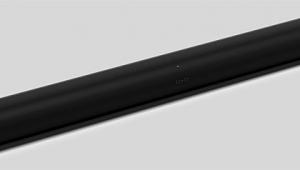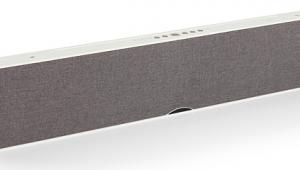Review: PSB Imagine W3 soundbar and W1 on-wall speaker Page 3
Measurements
Frequency Response
• W3 left/right 113 Hz to 20 kHz ±4.1 dB, ±2.9 dB to 10 kHz
• W3 center 107 Hz to 20 kHz ±4.9 dB, ±2.9 dB to 10 kHz
• W1 108 Hz to 20 kHz ±6.4 dB (±3.8 dB freestanding), ±6.4 dB to 10 kHz (±3.0 dB freestanding)
• sub 27 to 157 Hz ±3.0 dB
Sensitivity (2.83 V @ 1 meter, 300 Hz to 10 kHz)
• W3 left/right 83.1 dB
• W3 center 86.5 dB
• W1 85.5 dB (on-wall)
Impedance (minimum/average)
• W3 left/right 5.2/8 ohms
• W3 center 5.0/8 ohms
• W1 5.4/8 ohms
Bass output, subwoofer (CEA-2010A standard)
• Ultra-low bass (20-31.5 Hz) average: 103.7 dB
20 Hz 86.8 dB
25 Hz 100.7 dB
31.5 Hz 110.3 dB
• Low bass (40-63 Hz) average: 120.9 dB
40 Hz 118.2 dB L
50 Hz 120.2 dB L
63 Hz 123.5 dB L
Bass limits
• W1 50 Hz at 94.2 dB
• W3 center 50 Hz at 88.6 dB
I measured the W1’s frequency response with the speaker attached to a 2-by-4-foot baffle that mounts on a custom stand atop my measurement turntable. The baffle, which is surrounded by foam to absorb diffraction from the baffle edges, simulates the effect of on-wall mounting. Unfortunately, the W3 soundbar was too long to fit the baffle, so I placed it atop my usual 2-meter-high measurement stand. In both cases, the Audiomatica MIC-01 measurement microphone was positioned 2 meters from the tweeter. These measurements used quasi-anechoic technique to eliminate the effects of reflections from nearby objects; a thick pile of attic insulation absorbed sound reflections from the ground. I averaged the measurements at 0°, ±10°, ±20°, and ±30° and smoothed them to 1/12th octave. Bass response was measured by close-miking the woofers and passive radiators, then summing their responses and splicing them to the quasi-anechoic response at 180 Hz. To measure the frequency response of the SubSeries 200 subwoofer, I used ground plane technique with the microphone on the ground 2 meters from the sub; this was smoothed to 1/3rd octave. Results are normalized to 0 dB at 1 kHz, except for the sub response, which is normalized to peak at +3 dB. Grilles were left on for all measurements. All frequency response measurements were made with a Clio 10 FW audio analyzer then imported into a LinearX LMS analyzer for post-processing.
The responses of the W3 and W1 measure about the same. The W1 and all channels of the W3 show a mild dip in the upper mids/lower treble, typically 2 to 3 dB, from about 1.8 to 3.8 kHz. All show a downward tilt in the treble response, which suggests sound that’s a little on the “soft and forgiving” side. All show a big peak at 17 kHz, likely the result of either a tweeter resonance or maybe a reflection between the front baffle and the perforated metal grille.
Obviously, the W1 shows a big 10-dB dip at 640 Hz, which is the result of mounting the speaker on the baffle for measurement. Wall-mounting the W3 would produce a similar effect. The bass boost of roughly 6 dB at 200 Hz is also likely the result of the baffle; the W3 shows a similar but much milder bump of about 3 dB.
Off-axis response of the W1 is excellent when the speaker is mounted vertically, with just a smooth treble rolloff and no significant midrange response anomalies even way out at ±60°. Off-axis response of the W3 is very good in the center channel, at least for a woofer/tweeter/woofer horizontal driver arrangement; not until you get out to ±60° do you see midrange anomalies (a dip of 10 dB at 1.5 kHz). For the left channel, the off-axis response is inconsistent from side to side, which is expected because the relative distances between the woofer and the mike and between the tweeter and the mike change as you move off-axis: It’s smooth on the right side, but it dips down 12 to 16 dB between 2 and 3.2 kHz on the left side.
Impedance and sensitivity of all models are high enough that any receiver should be able to drive them to high levels. The W1 drops to a low of 5.4 ohms/–6° phase at 235 Hz. The W3’s left channel minimum is 5.2 ohms/–18° at 240 Hz, while its center channel minimum is 5.0 ohms/–5° at 265 Hz. Note that the W1’s sensitivity measurement is artificially boosted by an average of approximately 3 dB due to being mounted on a baffle for the measurements. Also note that the W3’s measurements were taken with no boundaries near; expect an added 2 to 4 dB for in-room use, and another 3 dB or so if you wall-mount it.
I did CEA-2010 output measurements for the SubSeries 200 subwoofer. I also used the same technique to get the bass-limits measurements for the W3 (center channel only) and the W1, with the speakers sitting on the ground and powered by an Outlaw Model 2200 amplifier. Sub measurements were taken at 3 meters, then scaled up so that they are equivalent to 1-meter results. An L next to a measurement indicates that the maximum level was dictated by the subwoofer’s limiter. The sub is outstanding for its size and good for its price (especially for a brand that’s not sold direct), with a brutal output of 120+ dB at 50 and 63 Hz. It also has solid response down to 20 Hz, which is rare for a sub of this size.
- Log in or register to post comments




































































